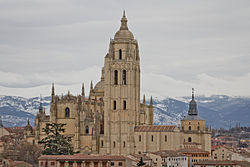Segovia Cathedral
The Church of Nuestra Señora de la Asunción y de San Frutos is the cathedral of the Segovia diocese , built in the period from the 16th to the 18th century in the Gothic style with some Renaissance elements. The cathedral is one of the newest Gothic cathedrals in Spain and Europe; At the time of the decisive construction phase from 1525 to 1577, mainly Renaissance buildings were already being realized in Europe.
Building history
The predecessor of today's cathedral was a church building begun around 1140 during the re-population of Segovia under Alfonso VII . This Marienkirche stood out as a building complex of different stylistic epochs.
Under Charles V , in the course of a popular uprising in Castile in 1520, his supporters occupied the old cathedral and destroyed it. In 1525, the cathedral chapter decided to build a new building based on designs by the architect Juan Gil de Hontanón, the builder of the new cathedral in Salamanca . The foundation stone was laid on July 8, 1525. In August 1558 the building was built up to the cruise ship and was consecrated as a cathedral. During the construction period, the Gothic cloister of the old cathedral from the 15th century was removed and rebuilt on the new cathedral. The historic choir stalls were also integrated into the new cathedral. In 1563 the construction of the Capilla Mayor began.
In 1614 the large spire was destroyed by a lightning strike. It was made of mahogany imported from America and covered with fire-gilded lead. The cathedral ceilings were also damaged by the fire. Around 1620, the tower was restored to its current shape, reduced by 12 m in height.
The cathedral was finally consecrated in 1768. It is 105 m long and 50 m wide. The central nave has a height of 33 m. The tower measures 88 m.
Furnishing
In the cathedral there are a number of furnishings from the first cathedral, especially in the side chapels that connect to the left and right of the aisles. Here you can find important paintings by Flemish painters from the 16th century and (especially in the Capilla de la Concepcíon) some paintings by the painter Ignacio de Ries from Seville.
In the choir chapel behind the choir there is a marble altar with relics of St. Frutos . It was designed by the artist Ventura Rodríguez for the chapel of the palace of Riofrío, but was never installed there.
In the choir area opposite the choir there are choir stalls from the 15th century and in the middle a choir desk by Vasco de la Zarza. The two grids of the choir area and the opposite choir room were forged in 1733 by the artist Elorza in Elgoibar.
Organs

The two organs in the choir area, each in the niches on the left and right opposite each other, date from the 18th century.
The organ on the epistle side was built in 1702 by the organ builder Pedro de Liborna Echevarría. Over the years the instrument has been changed several times, and most recently it was extensively restored in the years 2009–2011. The organ has a manual, the registers of which , like many Spanish organs, are arranged on the left and right of the console in the bass and treble side, so-called “mano izqierda” (left hand) and “mano derecha” (right hand). Not all registers are consistently preserved on the bass and treble side.
|
|
|
||||||||||||||||||||||||||||||||||||||||||||||||||||||||||||||||||||||||||||||||||||
literature
- All of Segovia, by María Jesús Herrero Sanz; Series: All of Spain; Editorial Escudo de Oro, SA, 5th edition; ISBN 84-378-1559-2
- Begoña Alonso Ruiz: The Construction of the Cathedral of Segovia from Juan Guas to Juan Gil de Hontañón (PDF). In: Karl-Eugen Kurrer , Werner Lorenz , Volker Wetzk (eds.): Proceedings of the Third International Congress on Construction History . Neunplus, Berlin 2009, ISBN 978-3-936033-31-1 , pp. 39-46
Individual evidence
- ↑ Information on the Epistle organ and its disposition (PDF; 8 kB) on the website of the Desmottes organ building company
Web links
- Cathedral website (Spanish, English)
- Cathedral on the website of the Comunidad de Castilla-León
- Website of the Diocese of Segovia
- Detailed description of the cathedral (Spanish)
Coordinates: 40 ° 57 '0.7 " N , 4 ° 7' 32.2" W.











